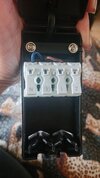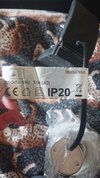I bought some bathroom downlights from screwfix a while ago, I already have old low voltage ones in that I did 12 yrs back and all the transformers have gone leaving Just 1 of my 6 lights working.
Anyway the ones I have are double insulated but on the spring clip fittings inside the plastic wiring box there is a connection for an earth.
Now It says in the instructions the light mustn't be earthed, so after researching a lot I'm still confused, sadly my dad (sparky) is no longer here to advise.
So what do I do with the cpc on the twin and earth, do I terminate it in the clip that's there, or just get a wago and connect each end of the earth on the chain into that and pop inside the fitting.
I've seen some electricians saying not to connect to the one provided on the light fitting. And some saying on other brands that don't have the earth terminal despite being double insulated that the manufacturer should have made an earth connector.
So do I just sleeve it and connect in a separate block to the one on the light or is it OK to put it in the fitting on the lamp considering its there already.
Fed up of keep going in the loft and not getting the job done lol
Anyway the ones I have are double insulated but on the spring clip fittings inside the plastic wiring box there is a connection for an earth.
Now It says in the instructions the light mustn't be earthed, so after researching a lot I'm still confused, sadly my dad (sparky) is no longer here to advise.
So what do I do with the cpc on the twin and earth, do I terminate it in the clip that's there, or just get a wago and connect each end of the earth on the chain into that and pop inside the fitting.
I've seen some electricians saying not to connect to the one provided on the light fitting. And some saying on other brands that don't have the earth terminal despite being double insulated that the manufacturer should have made an earth connector.
So do I just sleeve it and connect in a separate block to the one on the light or is it OK to put it in the fitting on the lamp considering its there already.
Fed up of keep going in the loft and not getting the job done lol




